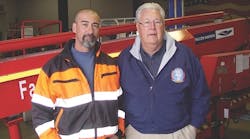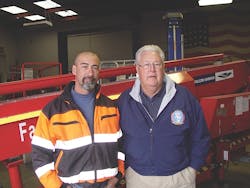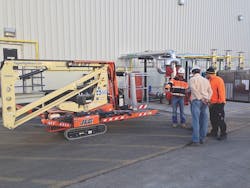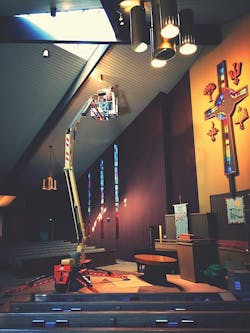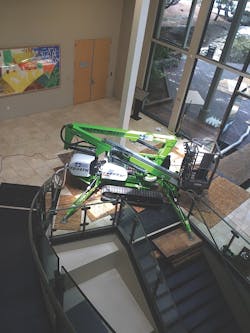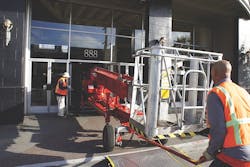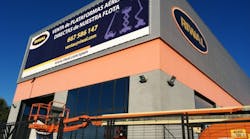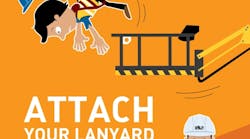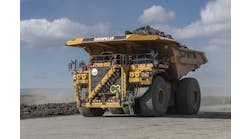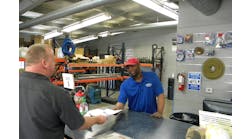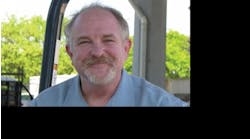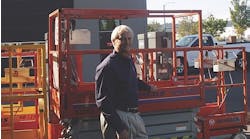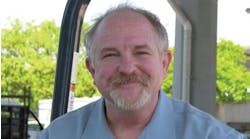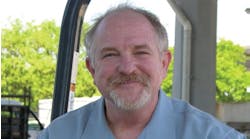There are hundreds of construction projects going on in the San Francisco Bay Area these days involving thousands of pieces of rented equipment. On many of them, you would probably see aerial work platforms rented by United Rentals, Hertz Equipment Rental, Sunbelt Rentals, H&E Equipment Services and a number of other familiar names.
A few specialized jobs with unique needs will feature equipment from Fagan High Reach & Equipment, based in Newark, Calif., in the East Bay south of Oakland. Most of its jobs are ones that most mainstream rental companies don’t go after, involving niche equipment and applications.
In the fleets of the above-mentioned rental companies and many others, be they national, regional or local firms, 19-foot scissorlifts and 60-foot boomlifts are common. If a customer wants a dozen or two on a project, they won’t be hard to find, and multiple rental companies will most likely compete to offer the cheapest rate, fastest -- and possible cheapest -- delivery, and newest machines.
There’s nothing wrong with any of that. It’s the equipment rental industry in 2016. But Fagan High Reach has taken a road less travelled, and that has made all the difference.
Fagan does offer some electric scissorlifts up to 31 feet. It offered some boomlifts in the past but no longer.
“We’re not interested in having 20 19-foot scissorlifts on a job,” says owner John Wetherholt. “We prefer the jobs where we rent two, three or four scissorlifts.”
Fagan specializes in niche items that aren’t easily found elsewhere. And along with the specialty lifts goes the ability to help customers set up challenging jobs, at a level the rental industry doesn’t often see.
Chief among the specialty items are atrium lifts, manufactured by Denka, Nifty and JLG, machines that combine height with very light weight. Specialty access lifts include 40-foot UpRight personnel lifts, a Skyjack 3220 with a 6-foot powered extension deck, Genie Runabouts and dual personnel lifts, and an UpRight Super Straddle.
“We’re not a general rental company, this is a boutique company,” says owner John Wetherholt, a 26-year veteran of the aerial equipment rental industry. “It’s all aerial, but it’s mostly specialty stuff. We’ve gotten out of booms. I don’t have anything here we can’t haul with a pickup truck and a trailer. We’re out of that.”
Without large delivery trucks and Class A drivers, Fagan’s cost structure is simplified. The company’s overhead is minimal. Its staff is small, consisting of owner Wetherholt; Chris Benson, who has no particular title, but is much like a partner and has an agreement to eventually acquire the company; Devin Bush, who specializes in marketing and a variety of other tasks; and part-time mechanic and fix-it man John Mahar, a retired fireman.
The lack of formal titles reflects the general camaraderie in a company where everybody does a bit of everything. “We all wear a lot of hats around here,” says Wetherholt.
Beyond Fagan’s unique fleet mix is its specialty service.
While almost every rental company claims to offer good service – and certainly many of them do -- Fagan has redefined the concept with its ability to offer setup of its specialty equipment. It offers machines that few if any competitors offer, specializes in getting those machines into places others can’t get their equipment into, sets jobs up and frequently stays onsite until the task is finished.
Super Bowl Scorecard
When millions of people watched the Super Bowl earlier this month, few spared a thought about the equipment that made it happen starting with the megawatts of power provided by Aggreko and a fleet of construction equipment. They certainly weren’t aware of a Denka atrium lift, a machine that reaches 92 feet high and weighs only 5,800 pounds, working near the scoreboard on the 700 level of Levi Stadium, in the days and weeks leading up to the game.
“[The stadium staff] has to straighten out modules and LEDs. It’s a big TV screen and it’s got these strips on it that have these LED lights and it’s all computer run,” says Benson. “There’s an 80-foot-wide sector of the sign that they decided not to put a catwalk behind. They put speakers behind it. So the only way they can change out the LEDs is from the front. The only way they can do it is to go up 80 feet in the air. And it’s on the seventh level and there’s a load restriction on the seventh level, you can’t get an 80-foot boomlift there.”
Fagan also has a JLG X390AJ, a track-mounted atrium lift on the rooftop at the Tesla Motor factory, reaching out over a parapet to hook up air ducting. “It was the only machine light enough to fit in an elevator and travel up on a rooftop,” says Wetherholt.
When technology is burgeoning, it means good opportunities for Fagan, located essentially in Silicon Valley. It has equipment at Apple, believed to be the largest construction project going on in the United States. Facebook is a regular customer and the company has rented to Google and other high-tech firms.
Benson is usually the specialist when it comes to going on a site and figuring out how to position a lift.
“The customers often can’t do the installation,” he says. “For example, at Facebook, they had to get a machine up to the second level. So the guys running the job said ‘We can’t figure that out,’ so they asked a few more sales reps, ‘How do we do this?’ And one of the guys fortunately said ‘Call these guys at Fagan, they will take care of that.’ And it’s a big difference. We have a different customer base. Eighty-five percent of the jobs that we do require some sort of difficult installation. So in addition to what we make on the rental, we make our money on the installation and set-up.”
When Fagan is called for a job, an employee walks through the site with the prospective customer. Customers typically come to Fagan with unique logistical challenges – getting a machine on a rooftop, in a steep stairwell to adjust or change lightbulbs, into the lobby of an office building, reaching high into the lobby ceiling of a hotel or office building in the middle of business. It rents machines that can reach high but are light enough and narrow enough to slide through office doors, travel on elevators, work on delicate floors without damaging them, maneuver into a church to adjust artwork or clean stain-glass windows. Fagan might be the only company on the West Coast that has an UpRight Super Straddle that can fit over theater seats or church pews. Often lifts have to be driven down ramps into difficult-to-reach areas, or someone needs to find a way to gain access where there are no ramps. Fagan also uses Denka lifts to repair lighting on muddy baseball fields where heavier lifts would just sink into the wet ground.
Wetherholt and Benson assess the site’s logistical challenges and determine entry and exit areas, what kind of machine could perform the task and how to position the machine. More often than not neither the customers nor contractors will have the expertise to set up the machines in such precarious situations and so Benson will set the machine up and sometimes be present when the work is being performed if necessary to maneuver the machine.
Everything from the walk-through on is charged for because of the uniqueness of the application.
“We get three times more money for these than anybody else does because everybody else bases their rental rates on the purchase price,” Benson says. “A total mistake! You have to charge what the machine is worth, not what it costs.”
The Fagan team offers a level of service far beyond that of providing a commodity. They also are dealing with machines that require special handling to avoid damages.
“One of the things that we decided was that if we’re going to get into this, we would keep control of the machine and one of the ways was, No. 1, do a job walk so we know what we’re getting into before we pull up at the curb,” Wetherholt says. “No. 2 is when we get in there, we charge for getting in there but we also take more time training them and we charge to train them up on how to operate it. And a lot of times Chris will stick around for a long time after that as they’re operating just to make sure that they understand how to use it. And we found that when we do that our incidence of issues on jobs are way down.”
Facebook Friends
In one job at Facebook headquarters there was no ramp to get from the parking garage to the second floor, so the lift had to be higher than the second floor. Using a reach forklift, Benson raised the machine up in the air over the hand railing down over the second floor, then went inside the building to position the machine onto a certain spot.
In another recent job at Facebook headquarters, the customer had spent all night trying to position a machine. “They had a weight limit on the floor and had to reach up about 55 or 60 feet,” says Benson. “The spot we’re in we had literally half an inch of clearance to get the machine to fit in there. We got it in.”
The UpRight Super Straddle is popular but difficult for customers to use properly. “The customer can get into trouble with this, it’s a soft floor and they can bang up those seats in a heartbeat,” says Benson, referring to a job where the Super Straddle was used inside a church. “You can wrestle with it and it can be very tippy if you don’t operate it right. There are techniques, if you know how to use this machine, how to lock the casters in a certain position, and other maneuvers and that’s where other rental companies might provide minimal information on how to operate the machine, but they don’t get it in there. When I get it in there, I’m also showing those guys how to get it down the aisles, moving from location to location, when to unlock the wheels, tips like that.”
Because many churches are changing to LED lighting, Fagan has been called into a number of similar jobs.
A good bit of Fagan’s business comes from referrals from sales reps of other rental companies that aren’t equipped to handle specialty jobs, yet don’t regard Fagan as a competitor. Often Fagan helps the other companies out by enabling them to help their customers find solutions for complex logistical challenges. And at the same time they’ll re-rent to Fagan when it needs certain items.
“The only reason the sales reps are willing to work with us is they know we’re not going to go back there and take their customer away from them,” says Wetherholt. “We’re not interested in going out and doing any of that. We can’t. We’re not equipped for it. We’re not a first-line high-reach company any more. We don’t have the equipment for that.”
Origins and Evolution
Fagan at one time was a more traditional high-reach company. Fagan Equipment was founded by Don Fagan in the early 1970s. He already had a career in the equipment rental business working for a company called Clementina, then one of the industry’s largest, in the Bay Area. He started Fagan Equipment as a means to buy and sell equipment. But it was the early years of aerial rental and as that business developed, Fagan Equipment grew into a high-reach rental company with a fleet of scissors and booms.
Wetherholt was hired as an outside salesman in 1989 with no background in equipment rental. Fagan told him he didn’t know if he would fit in and that he was planning to sell the company sometime soon. Nonetheless Wetherholt, who had a goal to own his own business by the time he turned 40, decided to give it a shot and within a few years was running the company. He acquired it a few years later.
“I ran it as a traditional high-reach company,” Wetherholt says. “We had two big trucks, we had 80-foot booms, we had 50s, we had 40s, we had regular scissors. We were a traditional high-reach company just like everybody else out there. But then times changed and one of the things that happened was [national companies] came in and I had to figure out a way to keep this thing going.
“There was no way I was going to run the company the way I had been running it. In the late ’90s we had a boom going on here, we had a certain momentum going so it was hard to start making changes but when everything busted in 2001, I sat down and basically I downsized this company. We used to be down the street here, we had a big yard. I decided that what I needed to do was downsize and run it as a company that could continue to be profitable in the Bay Area and continue to be in the high-reach industry. But I also knew that there was no way that I was going to be able to go out there and compete with United Rentals.”
Wetherholt completely downsized the company. “I had 13 people working here,” he says. “Actually for a time I opened up another branch, I had four or five in the shop, people in the office. Back in ’01 when the dotcom boom crashed, I re-did this company. I re-thought a lot of things and one of those things was outsourcing. I outsourced all the bookkeeping. That’s been 15 years now. I have a bookkeeper who comes in once every two weeks, for a long time it was once a week and then the recession hit and it was every two weeks. She’s part of a larger bookkeeping service that does my taxes, they file stuff for me, keeps up with the computer, they keep me square with the feds, keep me square with the state. All the regulatory stuff, they keep me up to date with that.”
Wetherholt downsized the fleet as well, focusing on scissorlifts and small forklifts and some articulated boomlifts and a few other items and did well enough through the ‘00s until the great recession hit around 2008. Then the bottom fell out and there was very little business at all. For the next few years, Wetherholt managed to scrape through and keep the doors open but times were lean.
A Denka in Trade
Somewhere along the way Wetherholt acquired a Denka lift, quite by accident. Fagan had a customer who had purchased a 19-foot scissorlift from the company and was struggling and unable to make payments. He contacted Wetherholt and told him he needed the machine to stay in business and offered to trade a Denka lift for it. Wetherholt decided to write off the scissorlift, accepted the deal and for a long time the Denka machine sat in a corner of the shop, not even functional.
Benson at the time was an outside salesman for United Rentals who occasionally did re-rental business with Wetherholt. He urged Wetherholt to get the unit fixed up and running, saying he had rental opportunities for it. But the machine had significant electrical and hydraulic problems and, at that time, no support from a manufacturer. When Benson eventually left United, they reached an agreement. If Benson could get the machine up and running, they could do a rental split on it.
It took Benson a whole winter to re-wire it and get it running.
“Chris, bless his heart, he worked on it out there for a whole winter and he re-mapped that whole machine,” says Wetherholt. “We had no help, and we since found people who knew Denkas, but we didn’t have anybody then, so he mapped it all out. He traced it all out. We figured out what was going on with it. We traced some different relays and we had to change some things, but we got it running. We had to re-wire a lot of things, because it had been messed up.
“We got it running and we pulled it outside here one day. I had no idea whether or not that machine had any value at all because those are aluminum boom sections on there and if any of them were bent and we’d have put it out for rent, it wouldn’t have been a rental machine and all that work would have been for nothing. So we pulled it out here one winter afternoon and got it running. We stretched it out and we both looked at each other like ‘Wow, we got something.’ It was worth it.”
They got a few rentals from it, but it wasn’t until the Levi Stadium (home of the San Francisco 49ers) long-term rental developed that the machine really began earning its keep. And with that the rebirth and new direction of Fagan High Reach came into being.
Once the stadium opened, the customer needed the lift before every game, and they started with that. Then they acquired the JLG track lift and now have four Denkas and are considering more.
Customers regularly call for the popular atrium lifts and personnel lifts, each of which has a name: Bambi, Ivy, Lucille, Hansel, Gretta, Long Tall Sally, The Flying Nun, Betty, Wilma, Maryann and Stretch. Customers will even call and say “I need to rent Lucille next week.”
Is Fagan’s niche likely to endure? Its staff sees a lot of opportunity. For example: “Here in the Bay area there are literally hundreds of these two-story buildings where the lobby area is two stories and there’s the curved staircase,” says Benson. “And 99 percent of the ones that you walk into there’s a burned-out lightbulb above the staircase and they don’t even know how to do the scaffolding because the staircase curves.”
It’s a lot more than burned lightbulbs that makes Fagan’s services attractive. The Bay Area was late to the recovery and should have some good years ahead. With a lot of creative architecture and the influence of new technology and the millennial generation, the possibilities appear almost boundless.
It’s the personal touch that makes Fagan unique. They’ll come out to the jobsite and figure out how to reach anything, how to get a job done. Even the machines have names. They’re not a commodity. They are almost human. Fagan High Reach & Equipment has the human touch like you’ve never seen it before. It’s not a big company, it’s a boutique. And it works.
